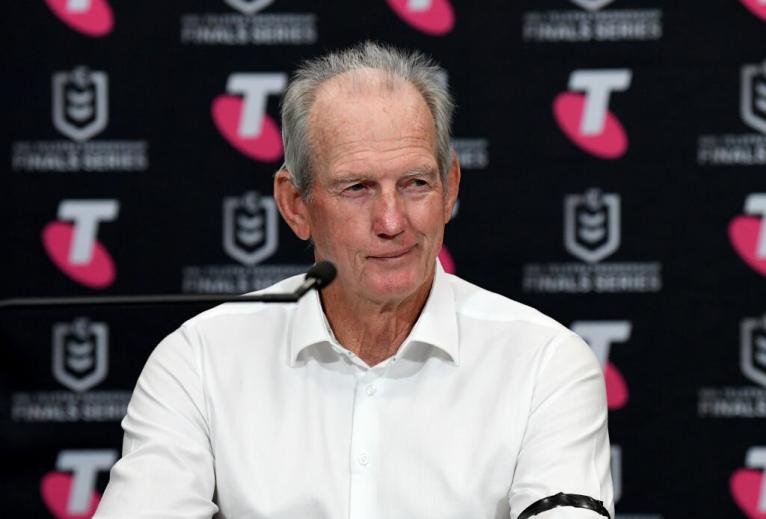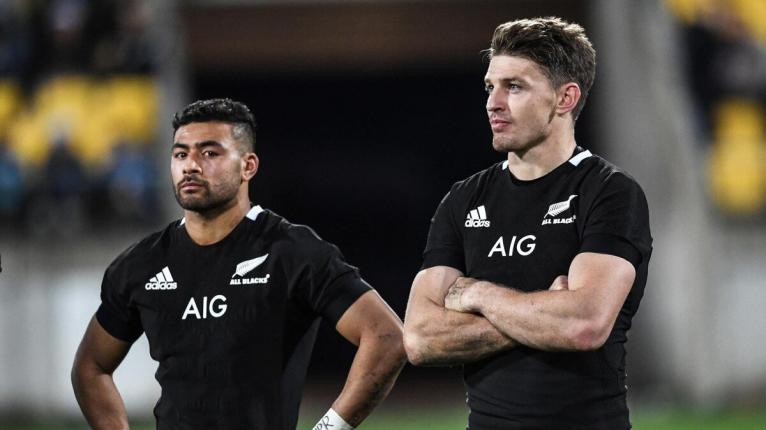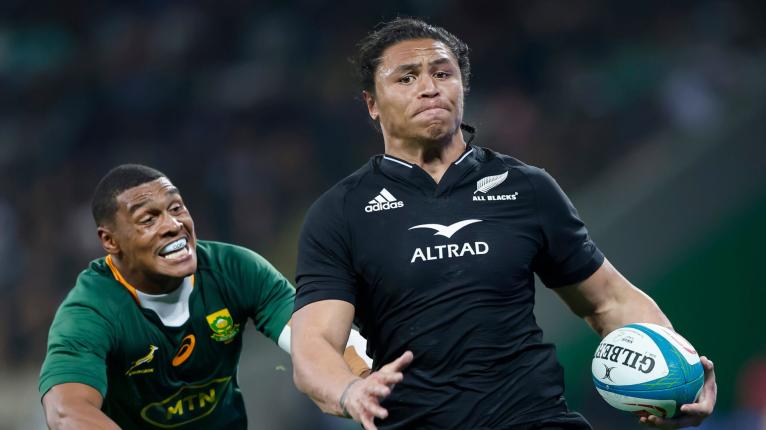New Zealand has not been guilty of getting too much wrong in its rugby history. Given the success of the All Blacks, the Black Ferns, its sevens teams and Super Rugby outfits, it’s not as if anyone could look at them, shake their head and wonder what on earth is going on.
This is a country steeped in success and yet, strangely, it does have one bad habit: one curious affliction that it suffers from and one that appears to flare up every four years when it comes to picking an All Blacks team to play at the World Cup.
The All Blacks have this weird problem of not being able to think straight when it comes to deciding who to pick at fullback at a World Cup.
It’s a problem they have suffered from multiple times and one from which they seemingly can’t learn.
This issue first surfaced in 1999 when the All Blacks, try as they might, couldn’t find the right player to replace the legendary centre Frank Bunce after he retired in 1998.

After he unexpectedly quit, the All Blacks suffered their worst season in living memory, losing five games consecutively in 1998. It was a horror show and by the end of the season, coach John Hart was beside himself trying to find solutions for the problematic No 13 jersey.
Over Christmas, he hit on an idea – he was going to shift Christian Cullen, easily the best fullback in the world and probably the best the All Blacks had produced, to centre.
Cullen had played there in his school days and Hart felt that with a bit of time and exposure to the position, Cullen could pick things up and be the solution. Jeff Wilson, meanwhile, would move from the wing to fill the newly vacated fullback position.
It wasn’t a disaster but nor was it a plan which worked and while Cullen went okay in his new role, the All Blacks missed his brilliant running game from the backfield and ability to beat defenders to launch incredible counter attacks.
No matter that playing a fullback at centre hadn’t worked in 1999, it was tried again in 2003 when Leon MacDonald found himself wearing No 13 in the semi-final.
Amazingly, having come into the job in 2004 promising he wouldn’t repeat the same mistake, Graham Henry did just that at the 2007 World Cup.
He had been competing for the fullback role with Mils Muliaina all year and then when injuries hit, MacDonald was shifted to centre. This wasn’t so much a case of the All Blacks getting things wrong at No 15 – more that it was further evidence that they held slightly questionable interpretations about the skillsets of a fullback.
Amazingly, having come into the job in 2004 promising he wouldn’t repeat the same mistake, Graham Henry did just that at the 2007 World Cup.
He had spent most of that cycle picking Muliaina at fullback, only to then have a mad moment and shift him to centre for the quarter-final against France.
Ironically, MacDonald came into the team at fullback and the thinking was unfathomable. Why had the All Blacks again refused to pick their best fullback at fullback?
As captain of the 2007 team, Richie McCaw would reveal in his book – a few months after that loss to France – that he, the coaches and other members of the All Blacks leadership group found themselves on stage with legendary NRL coach Wayne Bennett at a sports conference.

“Bennett walks on to the podium, looks straight at Ted [Graham Henry], Shag [Steve Hansen] and Smithy [Wayne Smith] and says, ‘I don’t know why the f— you’re sitting there and still got your jobs’,” McCaw wrote.
“Why were you playing guys out of position?’ he asks the coaches. While they were pondering that one, Bennett walks over to Mils who’s kind of scrunched down in his seat. ‘Did you want to play 13?’
“’Ah…’. ‘Where did you want to f—–n play, son? ‘Ah fullback,’ says Mils, almost apologetically.
“‘Well, what the f— were you doing playing centre?'”
Bennet’s harsh words obviously got through, because at the 2011 World Cup, Henry knew his own mind much better than he had in 2007 and the All Blacks – finally – picked their best fullback at fullback.
It seems so obvious and yet, come 2019 the All Blacks went back to a different way of thinking when they selected Beauden Barrett at fullback.
Israel Dagg was Henry’s choice, the youngster coming into magical form that year to oust the veteran Muliaina and give the All Blacks the counter attacking threat and high-ball security they needed.
The All Blacks won that tournament, and they won again in 2015 when they dropped Dagg and picked Ben Smith at fullback.
Smith began his All Blacks career on the wing, where he was quite brilliant, but his natural home was fullback and when the All Blacks employed him in that role, they were better able to utilise his ability to chase attacking contestable kicks and run from deep.
Again, the All Blacks won a World Cup in 2015 when they picked their best fullback at fullback, just as they did in 1987 when John Gallagher wore No 15.
It seems so obvious and yet, come 2019 the All Blacks went back to a different way of thinking when they selected Beauden Barrett at fullback.

To be fair, he did have considerable experience in the role and was arguably the best fullback in the country. But he spent most of the period between 2016 and 2018 playing No 10 and while he showed himself to be more than capable in the backfield, there are many who feel Smith was still the better option.
What’s troubling New Zealanders in 2023 is that Chiefs fullback Shaun Stevenson was not picked in the All Blacks Rugby Championship squad.
The 26-year-old Chiefs player has been the form No 15 all year – attacking brilliantly, playing others into space and thumping the ball long with his booming right boot.
By everyone’s estimation he’s been the best fullback in the country and yet he wasn’t able to crack the 36-man squad (although he was temporarily called up as injury cover for Mark Telea for the opening two games of the season).
All Blacks coach Ian Foster hinted that Stevenson missed out due to concerns about his defence. “We’ve got pretty specific job requirements on both sides of the ball,” Foster said.
What adds to the mystery of the All Blacks’ slightly odd interpretation of what they want from their fullbacks, is that the second best No 15 in the country is Will Jordan, and he’s never played a Test in his preferred role.
“On the attack side, he’s proven to be outstanding. He should be very proud of his year.
“We’ve seen a massive improvement in the defensive structural stuff – the tackle and the contact work – but we still want to see a bit more in that space.
“The fact he’s going to come in and be with us, maybe for those first two Tests, is a great opportunity to get a good read of that.”
It’s perhaps a fair assessment about Stevenson, but the same could easily be said of Caleb Clarke, who has held his place in the squad and started on the wing against Argentina.
Clarke has never convinced as a defender – either with his contact work or positioning – and yet he continues to play, while Stevenson is left out in the cold.

What adds to the mystery of the All Blacks’ slightly odd interpretation of what they want from their fullbacks, is that the second best No 15 in the country is Will Jordan, and he’s never played a Test in his preferred role.
He’s a miracle worker for the Crusaders at fullback – created a brilliant try against the Blues in the Super Rugby Pacific semi-final with his pace and instincts – and yet the All Blacks only pick him on the wing.
They fear his defence lacks bite and he’s not brave enough under the high ball and that’s why once again Beauden Barrett will be the All Blacks’ preferred fullback at the World Cup.
Barrett played all year at No 10 for the Blues, but Foster likes not only the solidity of the veteran’s defensive work and accuracy under the high ball, he also believes the two-times World Rugby Player of the Year is an excellent communicator and glues together the back three.
Again, there is validity to this rationale, and Barrett played well against Argentina and South Africa, scoring a try, setting up another, and making a number of strong contributions at first receiver, partnering well with both Damian McKenzie and Richie Mo’unga.
It all seems a bit mad and hard to understand but the All Blacks have a conviction that a fullback needs to be a defender first, attacker second
But tougher challenges await and it also doesn’t change the fact that the All Blacks are ignoring the merits of the two best fullbacks in the country to play a No 10 there.
And, probably, if anything should happen to Barrett, he’d likely be replaced by his brother Jordie who has played at inside centre for the Hurricanes all campaign.
It all seems a bit mad and hard to understand but the All Blacks have a conviction that a fullback needs to be a defender first, attacker second and that it is a role in which they can experiment and innovate.
That’s a risky belief – and one that has never worked for New Zealand in the past.
The three times the All Blacks went to a World Cup and played their best fullback at fullback, on the other hand, they won. Go figure.



The midfield of Jordie and Reiko needs all the gametime possible before the RWC as that is our best combination esp. in offering size & speed. Time together will further better their D and attack potential.
I would like to see a back three of Narewa right wing, Leicester Faiunganuku left, and Will Jordan FB.
Beauden can be a super sub.
Excellent notes, Gregor.
Shooter was by far the best fb in Super this year & has consistently been the past few years he deserved a chance in the Abs to showcase his skills but no Foster snubbed him, it's crazy you have two of the best fbs in the world one can't even make the squad the other is played on the wing but in saying that I do like BB at fb think he's better suited there as he has more time & is able to utilize space better with his pace & kicking game so moving forward Mo'unga & Dmac are our 10's
I think foster is an idiot Shaun deserves one game as he's been in form for multiple years I'd love to see him off the bench against the wallabies if you watched the chiefs thi season when he came off the bench he was incredible just brang that boost of energy and opened up so much space. Come on foster don't lose him to over seas teams
The skill sets needed for the back three are not too.different from each other. Centre with back three many more differences.
I hate to say it but, this time, I agree with Foster with regard to Stevenson. Jordan still learning, poor technique under high ball so wing is better. Having said that both Will and Beaudie need to be on the park. They both offer too much. Bennet was right. Gregor I believe you have it 99% right here.
Can't compare this fullback story with those gone past. Fullbacks at centre cost us, not a 10/15 at 15.
And Foster calling out Stevenson's D doesn't hold water when he selects Jordan, Clarke, Fai'inganuku, Ioane,.... Who have i missed?
Hahaha that is so like Mils on The Breakdown it's not funny.The story reads more of a problem with centers than full backs but I do agree that a strong counter attack starter is key to the All Blacks playing to their potential. While this site has rated both Barrett's performances a 9 I think they would be better with Stevenson there. Though I also thought Reiko too valuable on the wing and that he would sort out his defensive reads in time for the WC to be a better option at center.
Stupid article. In all of his previous examples they took the best 15, and moved him to another position. That's not what's happened here, Barret is still the best 15 at Test level, he just can also play 10. Having him and Mounga on the field is massive for NZ and clearly fixed a lot of their problems they previously had.
Foster saying Stevenson is a defensive liability is a cop out for him because Stevenson it's actually quite sound in defense and actually the 3rd best defensive player out of all the back 3 players picked it's just a cop out for him so he can pick his love interest Foster has never been good at picking teams